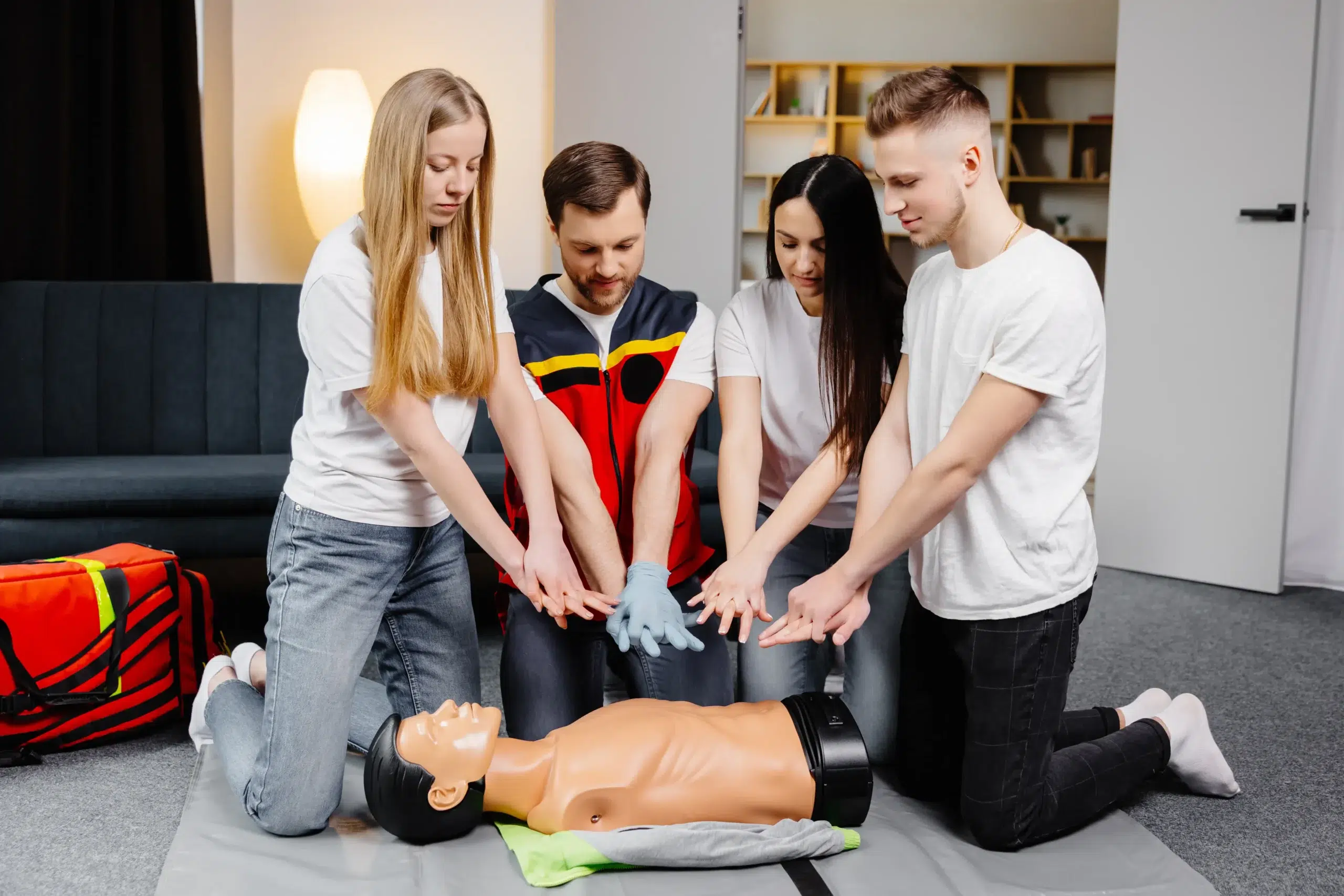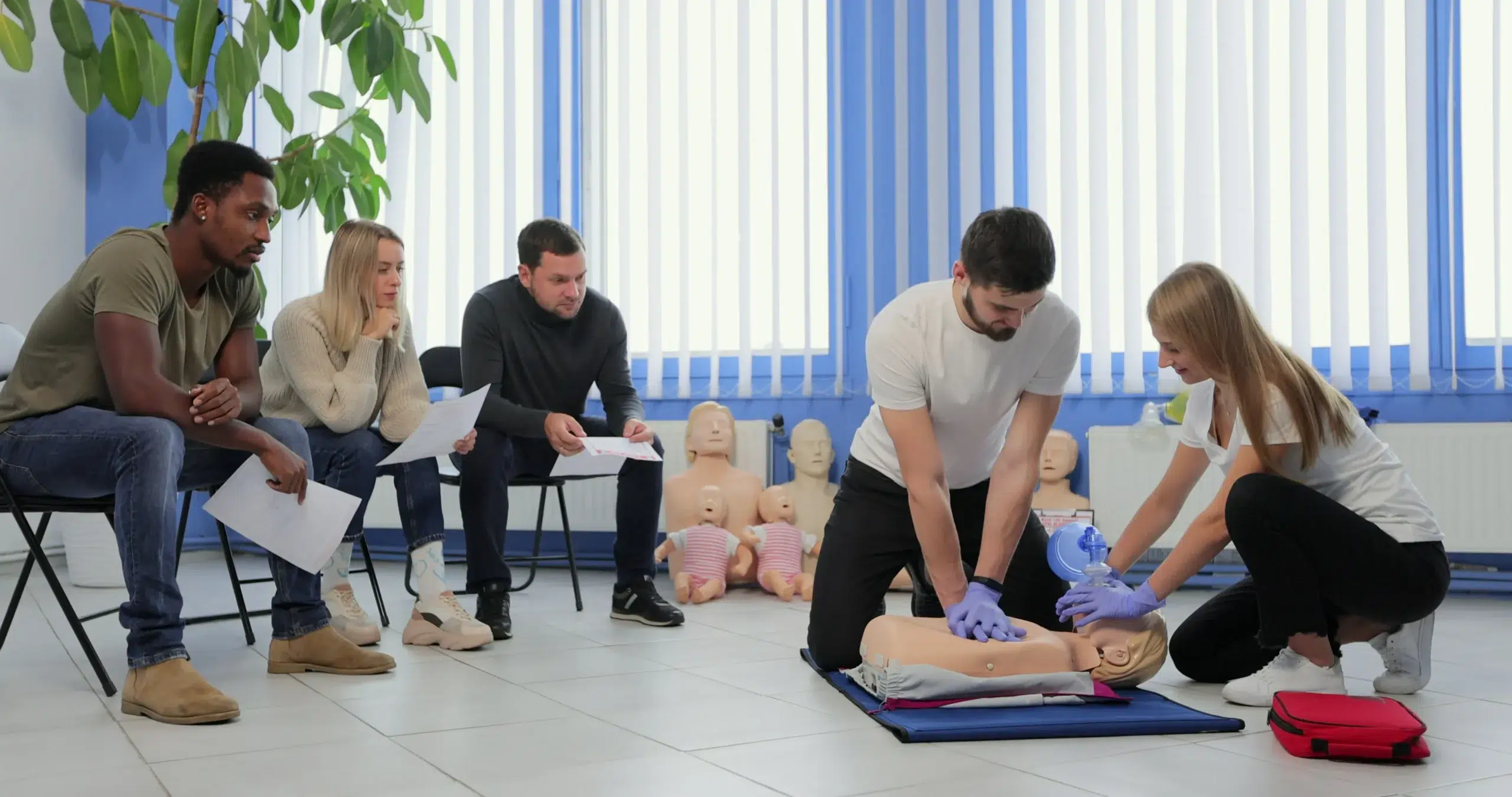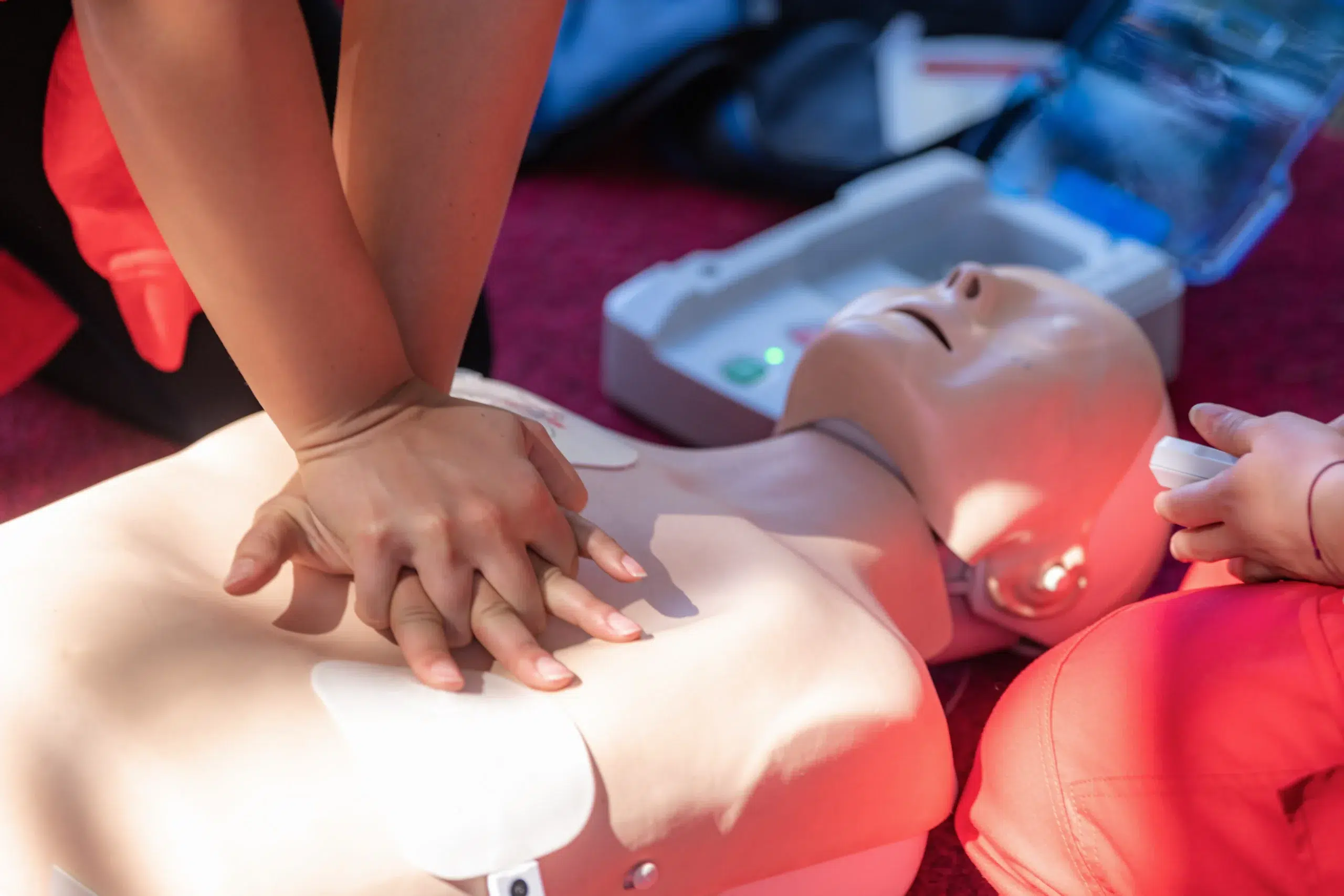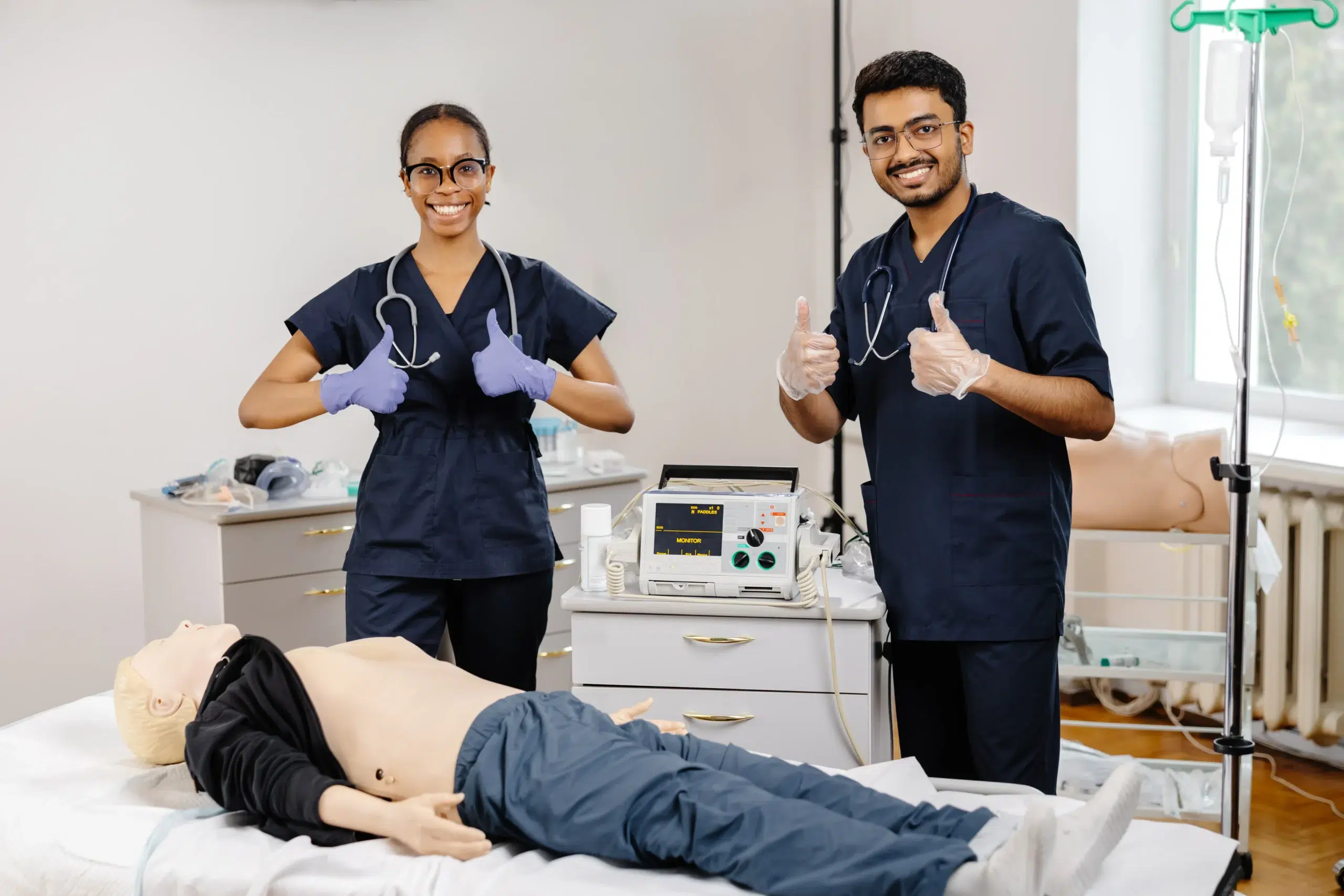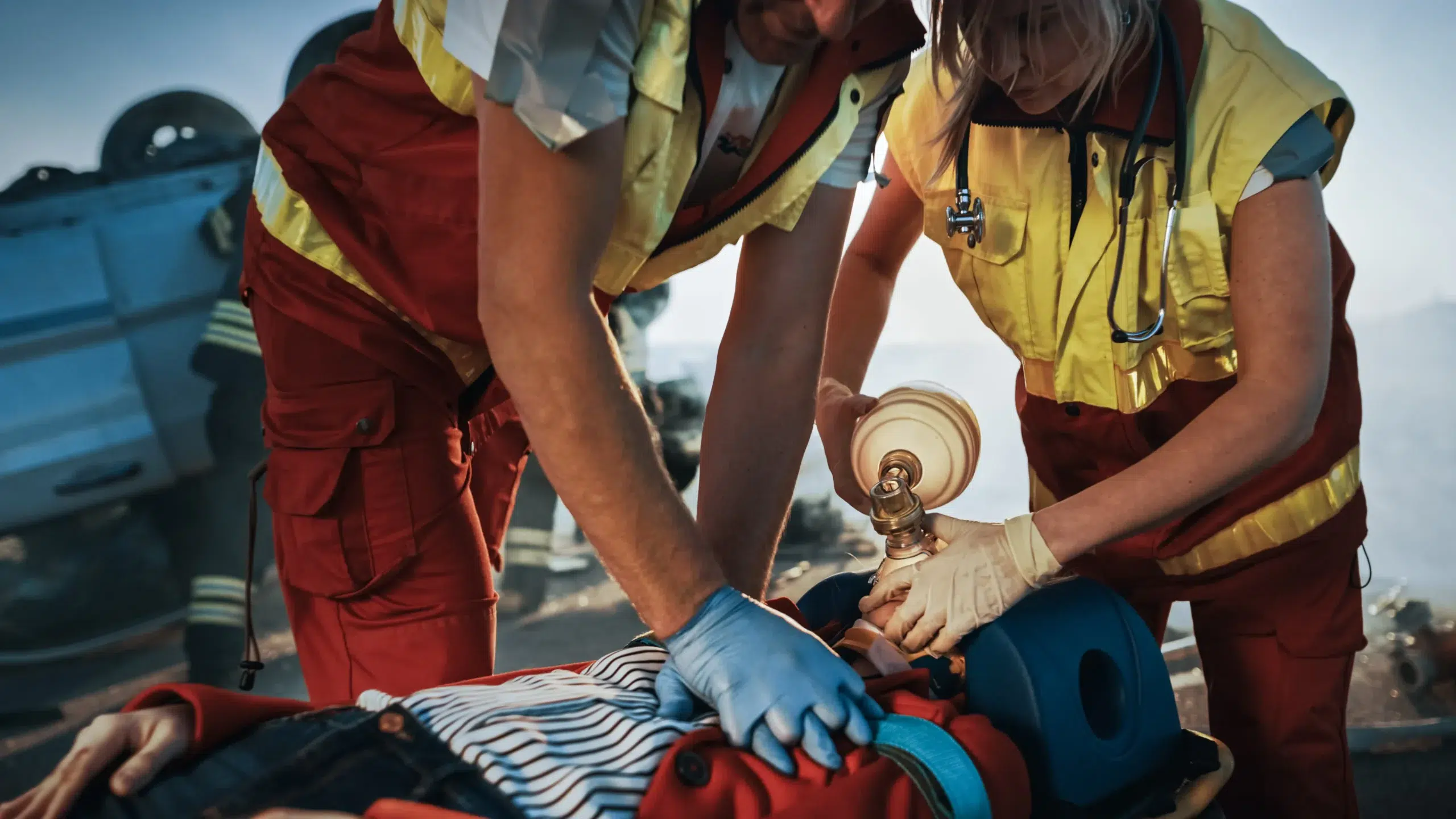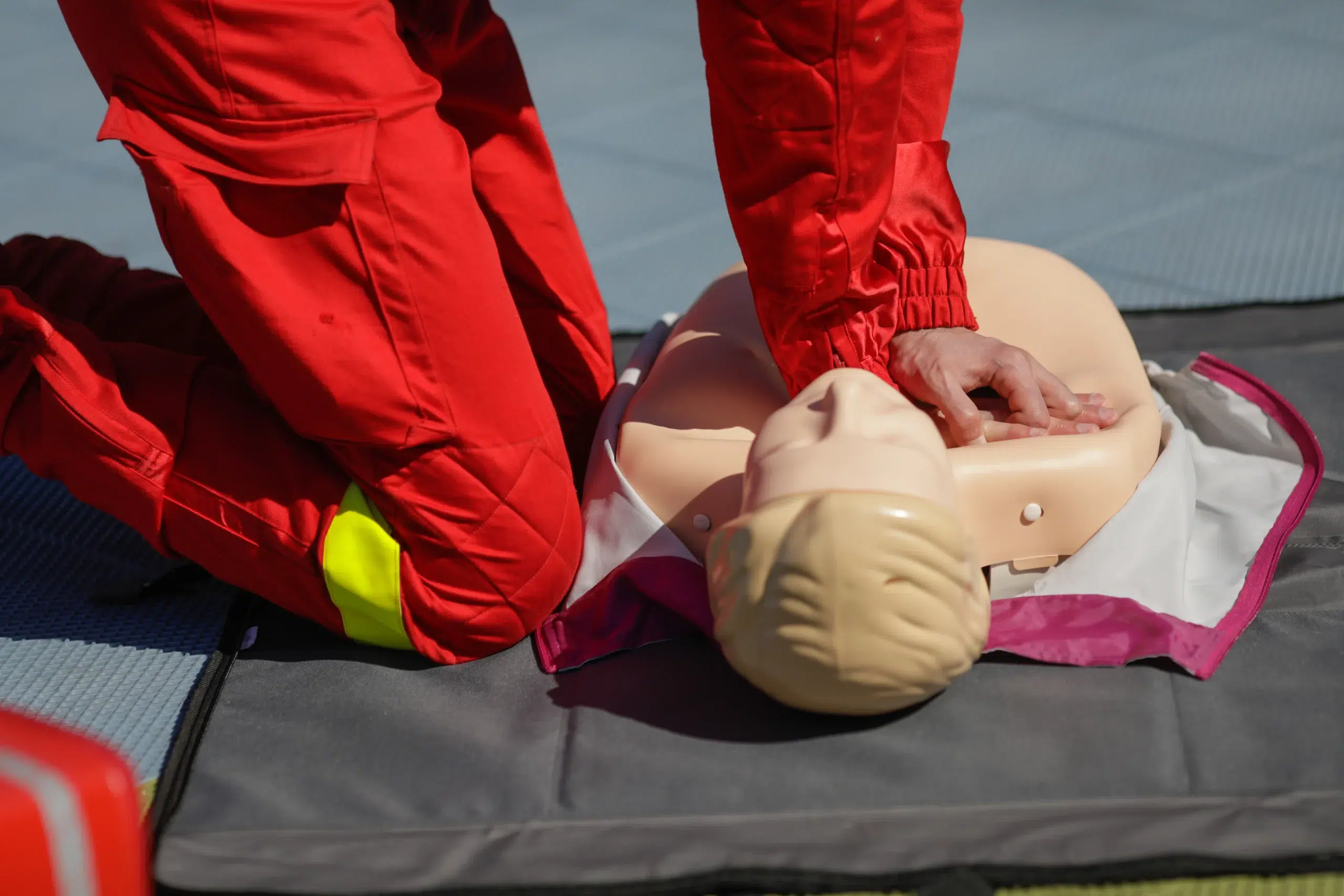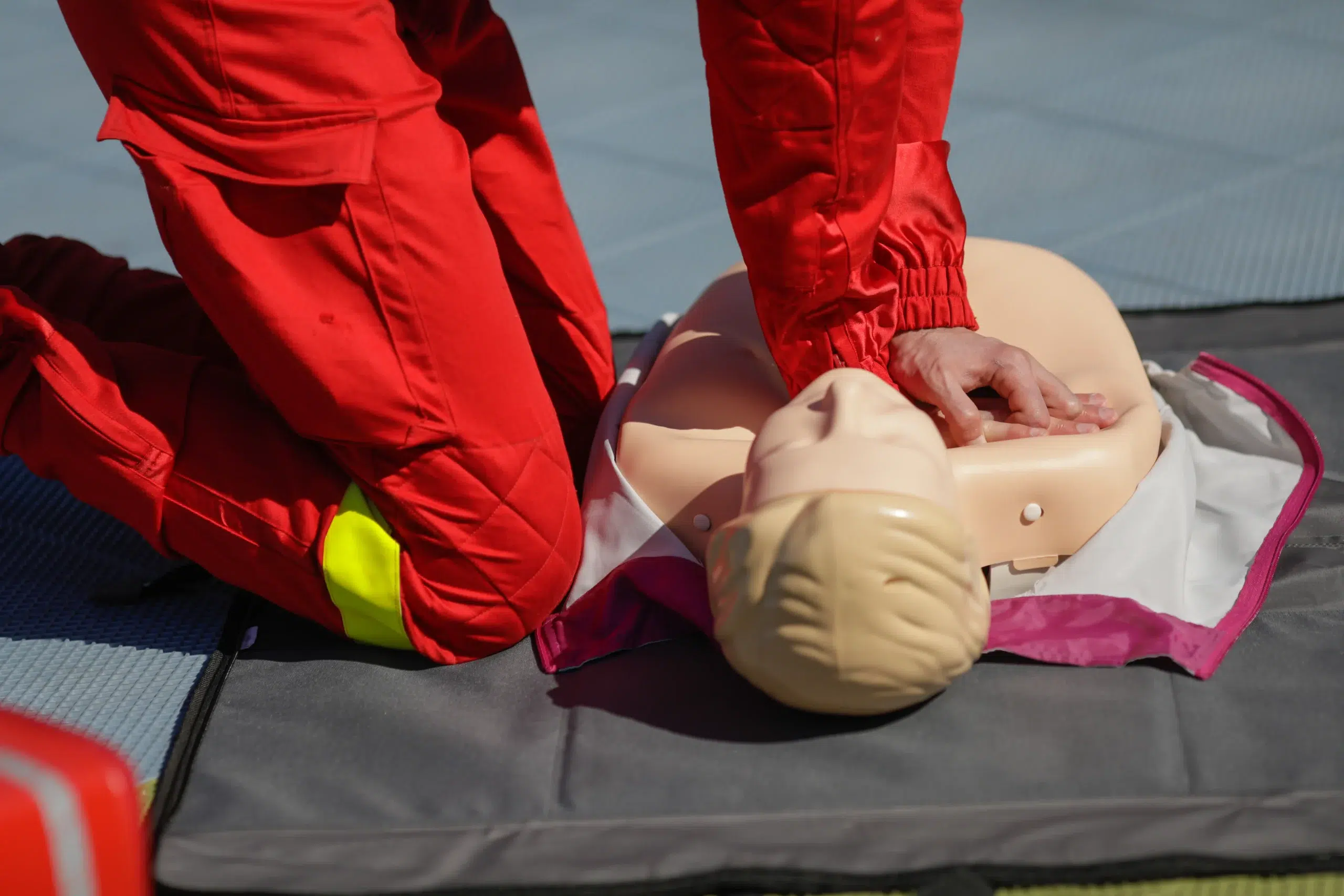In times of crisis, seconds can matter. Basic Life Support (BLS) certification equips you with the skills to respond effectively in medical emergencies, providing essential care until professional help arrives. This certification is more than just a credential—it’s a testament to your ability to remain calm and act decisively when it matters most. This comprehensive guide covers everything you need to know about BLS certification, from understanding the core skills to finding a “BLS certification near me.” We’ll explore the various types of BLS courses, the cost and value of certification, and how to maintain your skills to ensure you’re always ready to help.
Key Takeaways
- BLS certification equips you with life-saving skills. Learn CPR, how to use an AED, and relieve choking—essential skills for healthcare providers and anyone who wants to help in a crisis.
- Find a BLS course that suits your needs. Whether you prefer in-person instruction, online learning, or a blended approach, there’s a BLS course format that fits your schedule and learning style.
- Stay current with your BLS certification. Renew your certification every two years to maintain your skills and stay up-to-date with the latest life-saving techniques.
What is BLS Certification?
Basic Life Support (BLS) certification gives you the skills to respond to life-threatening emergencies. It’s a critical credential for healthcare providers and anyone who wants to help in a crisis. BLS equips you with the knowledge and practical skills to perform CPR, use an AED, and relieve choking. These skills can make a real difference in survival rates for cardiac arrest and other emergencies. Think of it as essential training for anyone who might be the first responder in a critical situation.
Core Skills You’ll Learn
BLS certification courses cover core life-saving techniques. You’ll learn how to recognize the signs of a cardiac arrest or respiratory distress and immediately begin high-quality CPR. The training includes how and when to use an AED, a portable device that can help restore a normal heart rhythm. You’ll also learn how to manage choking in both adults and children. These skills are practiced through hands-on training and simulations, ensuring you’re prepared to act quickly and confidently in a real emergency. Most CPR and First-Aid courses in San Jose, CA through Safety Training Seminars.
Who Needs BLS Certification?
While BLS certification is crucial for healthcare professionals like doctors, nurses, and EMTs, it’s valuable for many others. Anyone working in healthcare, from clinical officers and pharmacists to healthcare assistants, benefits from this training. But it’s not just for medical settings. Childcare providers, teachers, coaches, lifeguards, and even parents can gain confidence and preparedness by becoming BLS certified. Having more people trained in BLS means more people ready to respond effectively in emergencies, creating safer communities for everyone. It’s a powerful skill set that empowers individuals to save lives.
Find BLS Certification Near You
Safety Training Seminars in San Jose
If you’re in the San Jose area, Safety Training Seminars offers a variety of American Heart Association (AHA) certification courses, including BLS, ACLS, PALS, CPR, and First Aid. They offer courses daily and have a dedicated support team to answer any questions. Serving San Jose, Santa Clara, and Sunnyvale, their convenient location makes finding a class that fits your schedule easier. Check their website for more information on their low price guarantee and CPR and First Aid courses.
Other Local Providers
While Safety Training Seminars is a great option, exploring other providers is always a good idea. A quick search for “BLS certification near me” will reveal other training centers and organizations in your local area. Look for providers offering AHA-approved courses for the widest acceptance.
Online Course Locators
Online learning has become increasingly popular, and BLS certification is no exception. The American Red Cross, for example, offers a blended learning program combining online coursework with in-person skills sessions. This lets you learn the material at your own pace and then demonstrate your skills practically. Other organizations like ACLS.com provide fully online, accredited BLS certification courses recognized by organizations like the American Dental Association (ADA) and the American Nurses Credentialing Center (ANCC). These online options are especially convenient for busy professionals or those who prefer flexible learning.
Types of BLS Certification Courses
When it comes to BLS certification, you have several learning options. Understanding the differences can help you choose the best fit for your schedule and learning style. Let’s break down the main types of BLS courses: in-person, online, and hybrid.
In-Person Training
Traditional in-person BLS training offers a structured learning environment with face-to-face interaction. These courses typically involve lectures, demonstrations, and hands-on practice. You’ll work closely with a certified instructor who can provide immediate feedback and guidance. This direct interaction allows you to ask questions, clarify doubts, and build confidence in your skills. If you thrive in a classroom setting and value direct interaction, in-person training might be your best bet. Check out the American Heart Association BLS courses offered by Safety Training Seminars.
Online Options
For those with busy schedules or who prefer self-paced learning, online BLS training offers a flexible alternative. You can study the material anytime, anywhere, at your own speed. Many online courses cover the same core BLS concepts as in-person classes. However, keep in mind that online BLS certification usually requires an in-person skills session. This means you’ll still need to demonstrate your skills to a certified instructor before receiving your certification. The American Red Cross offers a comprehensive online BLS course.
Hybrid Courses
Hybrid courses combine the convenience of online learning with the benefits of hands-on training. You’ll complete the theoretical coursework online at your own pace, then attend a shorter in-person skills session to practice and demonstrate what you’ve learned. This blended learning model offers a good balance of flexibility and practical application. It’s an efficient way to get certified, especially if you’re comfortable learning independently but still want the reassurance of in-person instruction. This approach has proven effective, as shown in research on basic life support training.
Choose the Right BLS Provider
Finding the right BLS provider is crucial for a valuable learning experience. Here’s what to consider:
Accreditation and Recognition
Look for a training provider affiliated with a nationally recognized organization like the American Heart Association. This ensures the course meets established standards and your certification is widely accepted. Safety Training Seminars offers AHA-certified courses, giving you confidence in the quality of instruction. A reputable provider like American Health Training offers comprehensive online BLS certification courses.
Instructor Qualifications
Experienced instructors make a big difference. Check if the instructors are healthcare professionals with extensive real-world experience. Their practical insights can be invaluable, especially when learning hands-on skills. See if the provider offers additional training or specialized courses beyond basic BLS certification.
Course Formats and Flexibility
BLS courses come in various formats: in-person, online, and blended learning (a mix of both). Think about your learning style and schedule. Online BLS courses offer flexibility, while in-person classes provide immediate feedback from instructors. Blended learning, combining online modules with in-person skills sessions, can be a highly effective approach, enhancing skill quality efficiently and cost-effectively, as highlighted in research on pediatric BLS training. Most BLS certification courses don’t have strict prerequisites, but be prepared to learn hands-on skills, practice CPR, and pass both a written and practical assessment.
Student Reviews and Testimonials
Reading reviews from past students can give you a feel for the quality of instruction and the overall learning experience. Look for comments about the instructors, course materials, and the training’s effectiveness. Consider the challenges others have faced, such as keeping up with changing guidelines during BLS renewal, and how providers address these. Understanding these recertification requirements can help you plan your recertification process.
BLS Certification: Cost and Value
Getting BLS certified doesn’t have to break the bank. Understanding typical costs and exploring available discounts helps you budget effectively and find the best value for your training.
Average Pricing
BLS certification courses are generally affordable, usually around $90 for initial certification and $60 for renewals. Be wary of providers charging significantly more—it’s always wise to compare prices. Safety Training Seminars offers competitive pricing and a low price guarantee to ensure you’re getting the best value.
Discounts and Group Rates
Many BLS providers, including Safety Training Seminars, offer discounts for group bookings. This is a great option for workplace training, schools, or community groups. Contact providers directly to discuss group rates and reduce the per-person cost. Some also offer discounts for students, military personnel, or other groups, so it’s always worth asking.
Low Price Guarantee
Look for training centers with a low price guarantee, assuring you the most competitive price. Safety Training Seminars offers this guarantee, giving you confidence in your investment. Check our online course calendar to find a class and contact us with any questions about pricing or which course is right for you. We’re here to help you find the perfect BLS course at the best possible price.
What to Expect in a BLS Course
So, you’ve decided to get your BLS certification—fantastic! Here’s a preview of what your BLS training will involve. Knowing what’s ahead can help you feel prepared and confident on course day.
Course Duration
BLS certification courses usually take about three to four hours. The exact time commitment depends on the provider and whether you choose an in-person, blended, or online format. While most BLS courses don’t have prerequisites, come prepared to actively participate. You’ll learn essential life-saving skills, practice CPR techniques, and complete both a written and a practical skills test. Check out our American Heart Association BLS courses to see what works for your schedule.
Hands-On Practice
Hands-on training is a critical part of any BLS course. You’ll learn how to perform chest compressions, give rescue breaths, and use an AED. Expect to practice these skills in a simulated environment with instructor feedback. This hands-on practice builds muscle memory and confidence in your abilities. Many courses now use blended learning, where you’ll complete some online coursework before a shorter in-person session for hands-on skills practice. Our CPR and First Aid courses in San Jose utilize this approach.
Assessment Methods
You’ll need to demonstrate your knowledge and skills through various assessments to receive your BLS certification. These typically include a written exam covering BLS theory and a practical skills test where you’ll perform CPR and other techniques in front of an instructor. Real-time feedback during these assessments can significantly improve your performance, both immediately after training and long term. Your instructor will guide you through the process and provide support. We also offer a low price guarantee, so you can feel confident you’re getting the best value for your training.
Prepare for Your BLS Certification
Getting ready for your BLS certification involves a little prep work before the course and some smart moves on the day of your class. These tips can help you feel confident and prepared, whether you’re getting certified for the first time or renewing your BLS skills.
Pre-Course Materials
Most BLS certification courses don’t have strict prerequisites. You should be prepared to learn hands-on skills, practice CPR, and pass both a written and practical assessment. Reviewing the course materials beforehand can make a big difference. A quick refresher on the BLS guidelines and protocols will help you absorb the information during the course. This preparation is especially important for recertification, as guidelines can change. Brushing up on the material ahead of time can help you avoid common pitfalls during the recertification exam.
Day-of Tips
On the day of your BLS certification course, remember these simple tips. Arrive a little early to get settled and avoid any last-minute stress. Dress comfortably, as you’ll be actively participating in demonstrations and practice scenarios. Bring a notebook and pen to jot down key points or any questions that come up. A water bottle is also a good idea. Most importantly, approach the training with a positive attitude and be ready to learn these essential, life-saving skills. Check with your chosen provider, like Safety Training Seminars, to see what’s included in their courses. They may offer online training resources or practice sessions to help you prepare. Managing any test anxiety you might feel can also contribute to a smoother experience.
Maintain Your BLS Certification
Keeping your BLS certification current is essential for any healthcare professional. Knowing the requirements and planning ahead helps ensure you’re always prepared to provide crucial, life-saving care.
Certification Validity Period
BLS certification is typically valid for two years. To maintain your credentials and stay up-to-date with the latest guidelines, you’ll need to renew your certification before it expires. Check your card or contact your certifying organization for your specific expiration date. Don’t let your skills lapse—stay proactive and prioritize your renewal.
Renewal Requirements and Options
Renewal usually involves completing a BLS provider renewal course, which covers any updates to guidelines and procedures. Finding a course that fits your schedule and budget is key. Look for providers, like Safety Training Seminars, that offer a low price guarantee to make the process more affordable. Set reminders and register for your renewal course well in advance to avoid last-minute scrambling. If your renewal requires an in-person skills check, factor that into your planning and schedule it promptly. Staying organized and informed about the process will help you maintain your BLS certification with ease.
Top BLS Certification Providers
Finding the right BLS certification provider is key to receiving high-quality training. Here are a few reputable organizations and companies that offer BLS certification courses:
Safety Training Seminars
Safety Training Seminars offers a variety of CPR and BLS certification courses in San Jose, CA, with a focus on hands-on training and real-world scenarios. This practical approach ensures participants are well-prepared for emergencies. They also offer a low price guarantee.
American Heart Association
The American Heart Association (AHA) provides widely recognized and respected BLS certification courses. Their training emphasizes high-quality CPR and the use of AEDs, equipping participants with the latest techniques and guidelines.
American Red Cross
The American Red Cross offers BLS certification and renewal training in both in-person and blended learning formats. Their curriculum covers essential skills such as CPR for adults, children, and infants, along with AED usage and other emergency medical procedures.
National CPR Foundation
The National CPR Foundation provides comprehensive BLS certification courses designed to meet the needs of healthcare professionals. With many courses accessible online, they offer flexible learning options while maintaining high training standards.
ProTrainings
ProTrainings offers a range of BLS certification courses that include video-based instruction and hands-on skills assessments. Their programs prioritize convenience and effectiveness, catering to both individuals and organizations.
Related Articles
- BLS Classes in Santa Clara: The Complete Guide – San Jose CPR Classes
- BLS Recertification Near Me: Your Complete Guide – San Jose CPR Classes
- BLS Certification in San Jose: Your Comprehensive Guide – San Jose CPR Classes
- BLS Courses in San Jose: Your Complete Guide – San Jose CPR Classes
- BLS Renewal Near Me: A Practical Guide – San Jose CPR Classes
Frequently Asked Questions
How long does BLS certification last, and how do I renew it? BLS certification is typically valid for two years. To renew, you’ll need to complete a recertification course before your current certification expires. This refresher course covers any updated guidelines and procedures. Check with your certifying organization or your BLS card for your specific expiration date.
What’s the difference between online, in-person, and blended learning for BLS? Online BLS courses offer flexibility, allowing you to learn the material at your own pace from anywhere. In-person classes provide a structured environment with direct instructor interaction and hands-on practice. Blended learning combines online coursework with an in-person skills session, offering a balance of flexibility and practical application.
What if I’m nervous about the skills test in the BLS course? It’s completely normal to feel a little apprehensive about the skills test. Remember, the instructors are there to guide and support you. The hands-on practice during the course helps build your confidence and muscle memory, so you’ll feel prepared when it’s time for the test. Focus on the techniques you’ve learned, and don’t hesitate to ask your instructor for clarification or feedback.
Why is BLS certification important for people outside of healthcare? While crucial for healthcare providers, BLS certification benefits anyone who might be the first responder in an emergency. From teachers and coaches to parents and childcare providers, having these skills can make a real difference in life-threatening situations. More people trained in BLS means safer communities for everyone.
How can I find a reputable BLS certification provider in my area? Look for providers affiliated with nationally recognized organizations like the American Heart Association or the American Red Cross. Check for instructor qualifications, course formats that fit your schedule, and read reviews from past students. Comparing prices and looking for discounts or a low-price guarantee can also help you find the best value.


